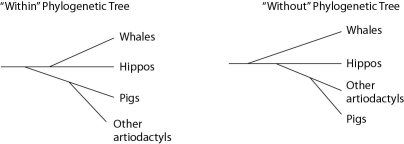Traditionally, whales and hippopotamuses have been classified in different orders, the Cetacea and the Artiodactyla, respectively. Recent molecular evidence, however, indicates that the whales' closest living relatives are the hippos. This has caused some zoologists to lump the two orders together into a single clade, the Cetartiodactyla. There is no consensus on whether the Cetartiodactyla should be accorded order status or superorder status. This is because it remains unclear whether the whale lineage diverged from the lineage leading to the hippos before or after the other members of the order Artiodactyla (pigs, camels, etc.) diverged (see Figure 20.2) .
 Figure 20.2 contrasts the "Within the artiodactyls" origin of the whale lineage with the "Without the artiodactyls" origin of the whale lineage.
Figure 20.2 contrasts the "Within the artiodactyls" origin of the whale lineage with the "Without the artiodactyls" origin of the whale lineage.
-What can be properly inferred from Figure 20.2?
Definitions:
Defendant's Motion
A formal request made to a court by the defendant challenging or asking for a specific action in a lawsuit.
Business Ethics
The use of ethics and ethical principles to solve business dilemmas.
Special Problems
Unique or complex issues that require specific attention or solutions.
Business Ethics
Principles and moral values that guide the behavior and decision-making process of individuals and organizations in the business environment.
Q1: Which of the following represents the treatment
Q9: All protists are<br>A) unicellular.<br>B) eukaryotic.<br>C) symbionts.<br>D) monophyletic.<br>E)
Q17: Which kingdom has been replaced with two
Q23: The existence of the phenomenon of exaptation
Q26: Which of the following is most closely
Q37: What is the pH of a 1-millimolar
Q49: Which pair of alternatives is highlighted by
Q53: You have two beakers. One contains a
Q80: Certain proteins of the complex motor that
Q127: Nitrogen (N) is much more electronegative than